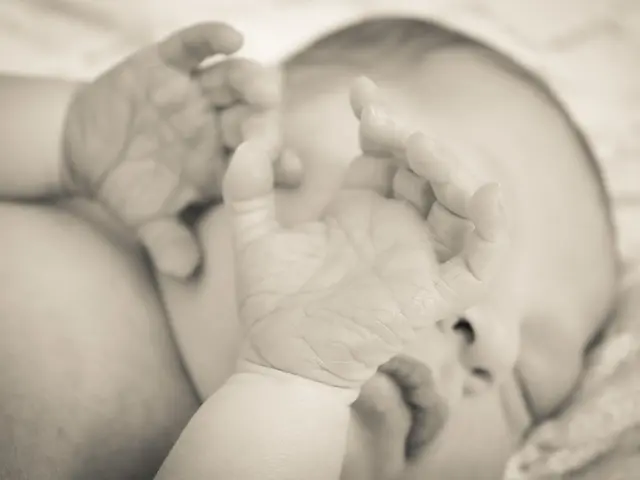Connection Between Breast and Ovarian Cancer: Causes and Risk Factors
Breast and ovarian cancer share a significant genetic link, primarily attributed to mutations in BRCA1 and BRCA2 genes. These genetic factors can predispose individuals to an increased risk of developing both types of cancer.
Research indicates that those who have had breast cancer may face a higher risk of developing ovarian cancer. This risk is particularly heightened for individuals who possess genetic mutations in BRCA1 or BRCA2. However, it's essential to note that this risk increment is primarily due to the underlying genetic factors rather than the disease itself.
According to recent research, people with breast cancer are approximately twice as likely to develop subsequent primary ovarian cancer. Conversely, ovarian cancer patients may have a 1.6-fold increased risk of developing subsequent breast cancer. The time since the initial cancer diagnosis may influence this risk, varying over time.
A family history of either cancer, older age, overweight or obesity, never carrying a pregnancy to term, and certain hormonal factors can also contribute to the risk of both cancers. Managing some of these risks, such as maintaining a healthy weight and altering dietary and lifestyle choices, may help reduce the risks.
Genetic testing for BRCA1, BRCA2, and other relevant mutations is a crucial strategy for monitoring and prevention. For those carrying genetic mutations, doctors may consider additional options such as prophylactic surgeries.
While some risk factors, such as having had breast or ovarian cancer previously, are unchangeable, regular screenings and careful monitoring under a healthcare professional's guidance can help manage these risks. This may include undergoing regular mammograms, breast MRI scans, pelvic exams, transvaginal ultrasounds, and CA-125 blood tests.
Mutations in the BRCA1 and BRCA2 genes are among the most significant shared risk factors for both breast and ovarian cancers. It's estimated that around 50% of families with ovarian and breast cancer have BRCA1 gene mutations, while around 20% have BRCA2 mutations.
Other risk factors for breast and ovarian cancers may include a family history of either cancer, older age, overweight or obesity, having a first child later in life, never having children, not breastfeeding, and hormone therapy after menopause.
People with both primary breast cancer and primary ovarian cancer appear to have a relatively favorable outlook, with 5- and 10-year overall survival rates of around 90%. The outlook is generally more positive when the interval between the two diseases is longer, and earlier diagnosis can improve outcomes.
For those who want more information about their individual outlook, they are encouraged to discuss their concerns with their healthcare team.
Individuals need to speak with a doctor if signs or symptoms of breast or ovarian cancer appear, particularly for those with a personal or family history of these diseases. Staying vigilant for signs of recurrence or a second cancer after a previous diagnosis of breast or ovarian cancer is crucial for early detection and prompt treatment.
Various resources are available for more evidence-based information and support for cancer patients and their families.
People with ovarian cancer may face an increased risk of developing other cancers, including breast cancer, bladder cancer, bile duct cancer, colorectal cancer, acute leukemia, and melanoma of the eye. Breast cancer can metastasize (spread) to the ovaries, although it is relatively uncommon.
Those at high risk of ovarian cancer include those who have BRCA1 or BRCA2 gene mutations, a family history of ovarian, breast, or colorectal cancer, Lynch syndrome, endometriosis, never been pregnant, had a late first pregnancy, or are over 40 years old.
In summary, breast and ovarian cancer share a strong genetic link, particularly regarding mutations in the BRCA1 and BRCA2 genes. A family history of either cancer, older age, hormonal factors, and reproductive history can also contribute to the risk of both cancers. Regular screenings, careful monitoring, and preventive measures can help manage the risks for those at higher risk.
- Individuals with a history of breast cancer may face a heightened risk of developing ovarian cancer, especially those who carry genetic mutations in BRCA1 or BRCA2.
- The time since the initial cancer diagnosis can influence the risk of developing subsequent primary ovarian cancer.
- Apart from mutations in BRCA1 and BRCA2, a family history of either cancer, older age, overweight or obesity, hormonal factors, and reproductive history can also contribute to the risk of both breast and ovarian cancers.
- For people with BRCA1 or BRCA2 gene mutations, genetic testing is crucial for monitoring and prevention, with doctors considering prophylactic surgeries as an additional option.
- Regular screenings, such as mammograms, breast MRI scans, pelvic exams, transvaginal ultrasounds, and CA-125 blood tests, can help manage the risks for individuals at higher risk.
- Both breast and ovarian cancer patients may face an increased risk of developing other cancers, making it essential for them to stay vigilant for signs of recurrence or a second cancer after a previous diagnosis.








